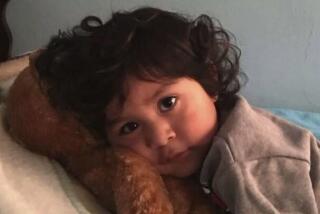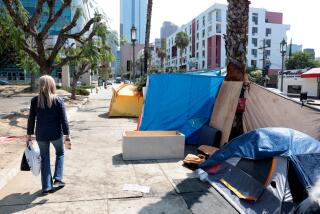‘Orphans of Addiction’ Are the Children of Us All
Three-year-old Tamika Triggs is safe today. Clean, fed and supervised by responsible adults, she no longer needs to pretend to sleep on her mother’s lap as the woman shoots up heroin and smokes crack cocaine. Los Angeles County social workers tracked down Tamika on Sunday after she was featured in a Times series, “Orphans of Addiction,” by urban affairs writer Sonia Nazario and staff photographer Clarence Williams. She now lives temporarily in the respite of a foster home.
Like Tamika, thousands of children have parents in name only, junkies or alcoholics who care more about a shot of heroin or vodka than a starving son or a sick daughter. The first step is finding and protecting these children. Teachers should be alert for telltale signs like chronic truancy; administrators should track youngsters who leave one school but don’t enroll in another. Women on welfare who give birth to drug-exposed babies should be guaranteed drug abuse treatment and their future cash payments should be made contingent on the results of random drug tests. And all witnesses to child abuse should call the 24-hour Los Angeles County hotline, (800) 540-4000. (A 20% increase in calls was reported Monday.)
Once kids like Tamika are found, however, their future still remains uncertain.
Part of the problem--a 1980 federal law that encourages states to reunite abused and neglected children with their abusive biological parents--will be corrected by legislation that President Clinton plans to sign Wednesday.
The bill will require states to terminate birth parents’ custody almost instantly if a child has been seriously abused or, in lesser cases, after the child has spent 15 months in foster care and the parents haven’t shaped up. While the legislation recognizes that child safety has to be paramount, it can do little to increase adoptions of abused children. (Of the 100,000 children available nationwide for adoption each year, only 20,000 find families.) So in addition to cracking down on abusive families, California officials must address the root causes.
One key is to expand the state’s child abuse prevention programs. A leading model in the public sector is Los Angeles County’s 28 “community family preservation networks,” wherein social workers organize key support systems for families that are good candidates for rehabilitation. These include help with drug treatment, housing, day care and jobs. The program has won national recognition for rehabilitating 85% of the families it assists.
A model for private sector reform is Keith Village, a Compton residential recovery program profiled in the Times series. Keith Village has helped dozens of parents and children recover from the emotional trauma of addiction.
State officials also should revise outmoded child protection funding laws. A 1992 state law requires counties to spend three-quarters of such funding on traditional foster and group homes. But children would sometimes be better off staying with a parent in a domestic violence shelter, for instance, or in a child care program attached to a substance abuse center. The state also should consider allowing mothers jailed for drug offenses to serve their sentences in residential treatment programs.
The success of programs like Keith Village and L.A. County’s family preservation networks proves that helping children like Tamika Triggs is well within our power. But the estimated number of abused and neglected children in this nation increased 149% between 1980 and 1993. There are so many more like Tamika who must first be found.
To Take Action: Financial contributions may be sent to Keith Village through SHIELDS for Families Inc., Kathy Icenhower, Executive Director, P.O. Box 59129, Los Angeles, Calif. 90059-0313. Take clothing or toys to SHIELDS at 2620 Industry Way, Lynwood, from 8:30 a.m. to 5 p.m. caption: Tamika Triggs on her mother’s lap.
More to Read
Sign up for Essential California
The most important California stories and recommendations in your inbox every morning.
You may occasionally receive promotional content from the Los Angeles Times.










